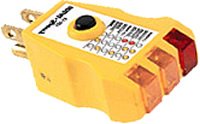tenders
Innocent Bystander
My inverter has three inputs on the DC side: positive, negative, and ground. The manual says:
Connect the Ground Cable to the appropriate location below:
a. If this unit is mounted within a vehicle with a grounded metal chassis, attach the Ground Cable to a nearby location on the chassis.
b. If this unit is mounted in a boat or vehicle with an ungrounded chassis, attach the Ground Cable to the vehicle’s grounding system.
c. Only if this unit is being used outside a vehicle, attach the Ground Cable to the Negative Terminal of the Inverter.
My boat does not have a "grounding system" per se, so I've just cross-connected the ground cable to the negative terminal.
This seems to work OK when I plug stuff directly into the inverter.
What I'd like to do, though, is power all the AC stuff in the boat through the existing AC wiring once in a while. But I'm finding it difficult to connect the output of the inverter to my shore power cables so I can effect this. When I use an extension cord, the inverter beeps and shuts down.
Could this be an issue with the way I've connected the grounding terminal? I'm wondering if there's some sort of inductance set up by the extension cord that trips up the inverter circuitry because of a bad ground. (And clearly I am not an electrical engineer.)
Thanks in advance for any insight on this!
tenders
1969 Ericson 32 #112
Muxie Duxer
City Island, NY
Connect the Ground Cable to the appropriate location below:
a. If this unit is mounted within a vehicle with a grounded metal chassis, attach the Ground Cable to a nearby location on the chassis.
b. If this unit is mounted in a boat or vehicle with an ungrounded chassis, attach the Ground Cable to the vehicle’s grounding system.
c. Only if this unit is being used outside a vehicle, attach the Ground Cable to the Negative Terminal of the Inverter.
My boat does not have a "grounding system" per se, so I've just cross-connected the ground cable to the negative terminal.
This seems to work OK when I plug stuff directly into the inverter.
What I'd like to do, though, is power all the AC stuff in the boat through the existing AC wiring once in a while. But I'm finding it difficult to connect the output of the inverter to my shore power cables so I can effect this. When I use an extension cord, the inverter beeps and shuts down.
Could this be an issue with the way I've connected the grounding terminal? I'm wondering if there's some sort of inductance set up by the extension cord that trips up the inverter circuitry because of a bad ground. (And clearly I am not an electrical engineer.)
Thanks in advance for any insight on this!
tenders
1969 Ericson 32 #112
Muxie Duxer
City Island, NY

